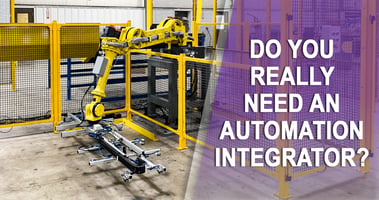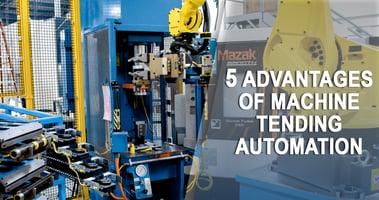When you’ve realized that automation can transform your business outcomes in some pretty...
4 Ways Packaging Automation Improves Business

In a number of today’s markets for consumer packaged goods, particularly food, beverages and other consumables, businesses are increasingly leveraging the advantages of automation to optimize their packaging lines and maximize profitability. Essentially, any production operation that involves placing a product into a form of packaging—from bottles, sleeves and containers to cardboard cases and skids—has the potential to reap benefits from integrating automation.
While some businesses hesitate to make the initial investment in packaging automation machines and technology, the longer-term returns and rewards simply can’t be overlooked. Automation has permeated so many aspects of production operations over the years, and for substantial reasons. We’re providing a detailed look at these reasons so you can make a more informed decision about whether packaging automation is a worthwhile consideration for your business.
1. Packaging automation minimizes contamination risks.
As consumers become more attuned to sanitation standards, and federal regulations tighten around food safety, players in the food and beverage industry are challenged to ensure product safety at every juncture of the production process, including packaging. Often, these functions must be carried out in a sterile environment.
Contamination by germs, pathogens, or foreign objects can amount to serious expenses in the form of discarded food, complex recall processes, loss of consumer trust, and legal liability. Because production and handling processes that rely on human workers carry increased risk of introducing contamination into the environment, a company that minimizes human contact is better positioned to minimize contamination risk.
Therefore, the more variables you can rid from your packaging process, such as human contact with either the product itself or a surface the product touches, the more potential sources of contamination you can eliminate. This is a major advantage of automating your packaging lines, as doing so substantially reduces the number of human touch points and mitigates overall safety risk for the final product.
2. Packaging automation solves critical labor challenges.
A universal truth for production companies is that labor is costly, difficult to source, and even more difficult to sustain. If you can’t keep pace with the number of human workers needed to achieve your volume, efficiency, and profitability goals, you certainly don’t want to be wasting the crew you do have on simple tasks that can be easily automated. It’s a problem you should be looking to solve.
This comes down to understanding where human capability adds value to your product (the kind that draws greater profit for your business), and where it doesn’t. In lots of scenarios where packaging is concerned, there’s really no added value to having human workers place products into containers.
It should also be noted that many of these processes involve tedious, unfavorable jobs for which worker retention is a huge expense. Automation lessens or completely eliminates the need for humans to perform these types of tasks, therefore cultivating a more amenable work environment—an important key to reducing turnover and minimizing labor costs.
3. Packaging automation promotes worker health and safety.
The outbreak of COVID-19 has launched the world into a new era, with companies in the production world scrambling to identify the smartest, safest paths forward. And while this particular virus may not last forever, the entire experience has been an eye-opening one, especially for operations that have historically relied on humans to work in close quarters with one another—which is often the case for employees on a packaging line.
Anywhere people are working in small, confined, or heavily populated spaces, there’s increased risk for exposure to a virus or other contagious health risk. Just one positive test result can lead to production declines or even a complete shutdown.
Remember, machines and robots don’t get sick. So as social distancing practices become the norm and businesses find themselves seeking alternate solutions to close human interaction, packaging automation looms even larger as a significant advantage.
There’s also inherent risk for employees in packaging roles who perform highly repetitive tasks over long shifts to suffer from work-related musculoskeletal disorders. According to the Bureau of Labor Statistics, these account for one-third of all workplace injuries and typically require more than a week of recovery time. By replacing humans with automation in areas that demand highly repetitive motions, you’re able to reduce the risk of worker injury.
4. Packaging automation enhances efficiency and profitability.
One of the most basic questions you should be asking to determine whether packaging automation is a worthwhile investment for your business is this: Would you have the ability to reduce your labor costs by running your packaging line at a faster pace?
To understand this better, let’s look at a typical pick-pack-palletizing process:
- The packaging (box, case, etc.) is erected.
- The product is placed into the packaging
- The packaging is sealed.
- The package is weighed to ensure proper product level.
- A label is applied and verified to confirm accuracy.
- The final product is placed on a skid and shrink-wrapped.
- The skid is transported onto a truck.
So many production companies run this process manually, from start to finish. And while each one of these steps is absolutely essential, there is zero value in having them handled by a human operator. In other words, the human component does not contribute to profitability. Most often, in fact, the human component slows down the process and impedes potential profitability.
For companies that embrace automation for these types of packaging scenarios, speed and efficiency skyrockets—at a pace that makes the ROI of the automation investment far outweigh the cost to employ more workers to achieve the same throughput.
Although large, global businesses have been recognizing and reaping this benefit of packaging automation for years, many regional manufacturers tend to throw more labor at their volume needs. These are the companies that are missing out on the serious bottom-line savings associated with packaging automation and who are at greater risk of losing their competitive advantage over the next decade.
More advanced means and opportunities for automation are undeniably refashioning how consumer goods companies operate their entire businesses. Be it for the goal of efficiency and accuracy or more streamlined operations and greater cost savings, evolving technology has revolutionized so many aspects of production, not the least of which is packaging. As you stay focused on your company’s business goals in the context of an evolving landscape, be sure to factor these benefits of packaging automation into your planning and decision-making efforts.



.jpg?height=200&name=Blog%20Post%2015%20-%20Banner%20Photo%20-%20FINAL%20(1).jpg)